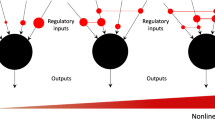Abstract
We introduce the nested canalyzing depth of a function, which measures the extent to which it retains a nested canalyzing structure. We characterize the structure of functions with a given depth and compute the expected activities and sensitivities of the variables. This analysis quantifies how canalyzation leads to higher stability in Boolean networks. It generalizes the notion of nested canalyzing functions (NCFs), which are precisely the functions with maximum depth. NCFs have been proposed as gene regulatory network models, but their structure is frequently too restrictive and they are extremely sparse. We find that functions become decreasingly sensitive to input perturbations as the canalyzing depth increases, but exhibit rapidly diminishing returns in stability. Additionally, we show that as depth increases, the dynamics of networks using these functions quickly approach the critical regime, suggesting that real networks exhibit some degree of canalyzing depth, and that NCFs are not significantly better than functions of sufficient depth for many applications of the modeling and reverse engineering of biological networks.
Similar content being viewed by others
References
Albert, R., & Othmer, H. (2003). The topology of the regulatory interactions predicts the expression pattern of the segment polarity genes in Drosophila melanogaster. J. Theor. Biol., 223, 1–18.
Balleza, E., Alvarez-Buylla, E., Chaos, A., Kauffman, S. A., Shmulevich, I., & Aldana, M. (2008). Critical dynamics in genetic regulatory networks: Examples from four kingdoms. PLoS ONE, 3(6), e2456.
Derrida, B., & Pomeau, Y. (1986). Random networks of automata: a simple annealed approximation. Europhys. Lett., 1, 45–49.
Drossel, B. (2009). Random Boolean networks, Chap. 3, pp. 69–110. Weinheim: Wiley-VCH Verlag GmbH & Co.
Gambin, A., Lasota, S., & Rutkowski, M. (2006). Analyzing stationary states of gene regulatory network using petri nets. Silico Biol., 6, 93–109.
Jarrah, A. S., Raposa, B., & Laubenbacher, R. (2007). Nested canalyzing, unate cascade, and polynomial functions. Physica D, 233, 167–174.
Karlssona, F., & Hörnquist, M. (2007). Order or chaos in Boolean gene networks depends on the mean fraction of canalyzing functions. Physica A, 384, 747–757.
Kauffman, S. A. (1969). Metabolic stability and epigenesis in randomly constructed genetic nets. J. Theor. Biol., 22(3), 437–467.
Kauffman, S. A. (1993). The origins of order: self-organization and selection in evolution. London: Oxford University Press.
Kauffman, S. A., Peterson, C., Samuelsson, B., & Troein, C. (2003). Random Boolean network models and the yeast transcriptional network. Proc. Natl. Acad. Sci., 100(25), 14796–14799.
Kauffman, S. A., Peterson, C., Samuelsson, B., & Troein, C. (2004). Genetic networks with canalyzing Boolean rules are always stable. Proc. Natl. Acad. Sci., 101(49), 17102–17107.
Li, F., Long, T., Lu, Y., Ouyang, Q., & Tang, C. (2004). The yeast cell-cycle network is robustly designed. Proc. Natl. Acad. Sci., 11, 4781–4786.
Nikolajewa, S., Friedel, M., & Wilhelm, T. (2006). Boolean networks with biologically relevant rules show ordered behavior. Biosystems, 90(1), 40–47.
Nykter, M., Price, N. D., Aldana, M., Ramsey, S. A., Kauffman, S. A., Hood, L. E., Yli-Harja, O., & Shmulevich, I. (2008a). Gene expression dynamics in the macrophage exhibit criticality. Proc. Natl. Acad. Sci., 105, 1897–1900.
Nykter, M., Price, N. D., Larjo, A., Aho, T., Kauffman, S. A., Yli-Harja, O., & Shmulevich, I. (2008b). Critical networks exhibit maximal information diversity in structure-dynamics relationships. Phys. Rev. Lett., 100, 058702.
Peixoto, T. P. (2010). The phase diagram of random Boolean networks with nested canalizing functions. Eur. Phys. J. B, 78(2), 187–192.
Saez-Rodriguez, J., Simeoni, L., Lindquist, J., Hemenway, R., Bommhardt, U., Arndt, B., Haus, U., Weismantel, R., Gilles, E., Klamt, S., & Schraven, B. (2007). A logical model provides insights into T cell receptor signaling. PLoS Comput. Biol., 3, e163.
Shmulevich, I., & Kauffman, S. A. (2004). Activities and sensitivities in Boolean network models. Phys. Rev. Lett., 93(4), 048701.
Shmulevich, I., Kauffman, S. A., & Aldana, M. (2005). Eukaryotic cells are dynamically ordered or critical but not chaotic. Proc. Natl. Acad. Sci., 102, 13439–13444.
Waddington, C. H. (1942). Canalisation of development and the inheritance of acquired characters. Nature, 150, 563–564.
Author information
Authors and Affiliations
Corresponding author
Rights and permissions
About this article
Cite this article
Layne, L., Dimitrova, E. & Macauley, M. Nested Canalyzing Depth and Network Stability. Bull Math Biol 74, 422–433 (2012). https://doi.org/10.1007/s11538-011-9692-y
Received:
Accepted:
Published:
Issue Date:
DOI: https://doi.org/10.1007/s11538-011-9692-y




